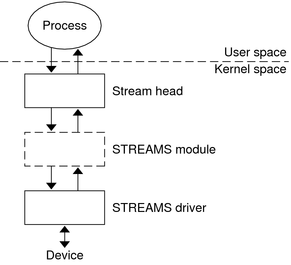| Skip Navigation Links | |
| Exit Print View | |

|
STREAMS Programming Guide |
Part I Application Programming Interface
Communicating With a STREAMS Device
How STREAMS Works--Application Interface
How STREAMS Works at the Kernel Level
Structure of a STREAMS Device Driver
Configuring Multiplexed Streams
2. STREAMS Application-Level Components
3. STREAMS Application-Level Mechanisms
4. Application Access to the STREAMS Driver and Module Interfaces
7. STREAMS Framework - Kernel Level
8. STREAMS Kernel-Level Mechanisms
11. Configuring STREAMS Drivers and Modules
14. Debugging STREAMS-based Applications
B. Kernel Utility Interface Summary
STREAMS is a general, flexible programming model for UNIX system communication services. STREAMS defines standard interfaces for character input/output (I/O) within the kernel, and between the kernel and the rest of the UNIX system. The mechanism consists of a set of system calls, kernel resources, and kernel routines.
STREAMS enables you to create modules to provide standard data communications services and then manipulate the modules on a stream. From the application level, modules can be dynamically selected and interconnected. No kernel programming, compiling, and link editing are required to create the interconnection.
STREAMS provides an effective environment for kernel services and drivers requiring modularity. STREAMS parallels the layering model found in networking protocols. For example, STREAMS is suitable for:
Implementing network protocols
Developing character device drivers
Developing network controllers (for example, for an Ethernet card)
I/O terminal services
The fundamental STREAMS unit is the stream. A stream is a full-duplex bidirectional data-transfer path between a process in user space and a STREAMS driver in kernel space. A stream has three parts: a stream head, zero or more modules, and a driver.
